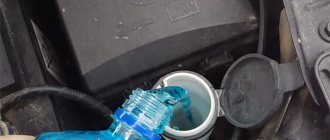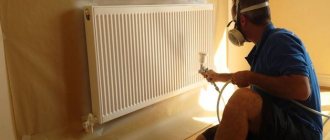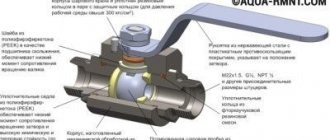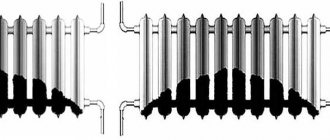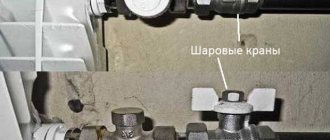What else you should know
If you are wondering how to turn off the battery if there is no tap, then there is a solution here too.
True, the option of blocking the riser is inevitable here. In this case, not only the individual battery will be blocked, but also part of the heating system. In small cities, the practice of turning off the heating independently is often used, just by shutting off the riser. It is turned off using a valve in the basement. At that point he approaches the sun lounger. Water valves are usually within sight. You can find out which fittings are suitable for shutting off the heating in the technical documentation. Additionally, this should be known to an experienced plumber who is familiar with local utilities. In most cases, the heating system is shut off using a brass valve or a valve.
In the event that the window sill blocks the battery, there is no single solution. It all depends on the degree of overlap. So, for example, if the window sill completely blocked the battery, then this is considered unacceptable. This is explained by the concept of convection, in which warm air rises. There it replaces cold air, which goes down, after which it is heated by the battery. Thus, the room is heated. If the window sill completely blocks the radiator, then the convection process is hampered and the room does not warm up well. But there will definitely be a way out of this situation. You can make several rectangular holes in the window sill and cover them with decorative grilles.
- So, shutting off the batteries in an apartment is possible and, in some cases, even necessary. This can be most conveniently accomplished with special taps.
- After the end of the heating season, it is recommended to close one of them and leave the second open.
- On the day of heating, we close both taps for 1-2 days so that rusty water flows and eliminates the possibility of blockages.
- If there is no tap, then you will have to shut off the riser using a special valve or valve, which are most often located in the basement of the building, and usually in a visible place.
The main thing is to do everything thoughtfully and strictly in accordance with all standards and requirements. Do not close both taps at the end of the heating season, this may cause deformation and cracks in them. Do not forget about the basic rules that will help you shut off the battery in your apartment safely and correctly.
Use of materials is permitted only if there is an indexed link to the page with the material. For any questions please contact
Battery shutdown
What to do when an accident occurs and the room is flooded with hot water, but there are no shut-off valves? Or are the connections to the battery not connected by a bypass? In an emergency situation, the temporary discomfort of the neighbors will have to be pushed into the background and the water in the battery must be shut off in any way.
After all, as a result of a breakthrough, significant material losses can be incurred not only by you, but also by your neighbors below, who will also be reached by the water.
Advice. If the leak is small, water just drips at the connection, then you have enough time to resolve the issue. You need to substitute some kind of container and contact the heating supply organization or a house mechanic by phone.
When the leak is significant and there is a risk of flooding in the room, you need to act quickly. The taps on the connections to the radiator must be closed, regardless of the absence of a bypass. If there are no fittings, then you need to make calls to all possible emergency services, and then try to shut off the entire riser yourself until they arrive. To do this, you will have to go down to the basement of the house and find the heating point of your entrance. In simple words, you need to find 2 vertical pipes going up from a horizontal collector of a larger diameter.
The valves or taps located at the insertion of both pipes into the manifold must be closed. In this case, not only your apartment will be left without heat, but also everyone else along the riser. In a good way, you need to go through all the apartments and warn your neighbors about the current situation, and hang a sign on the closed valves so that no one opens them again while you are undergoing repairs. If it was not possible to find the necessary valves, you will have to wait for the arrival of a locksmith or the arrival of the emergency service.
Conclusion. You can shut off your steel or cast iron battery in the middle of winter in two cases: when the piping scheme allows it and in the event of an emergency - in any case.
The right approach to covering
Owners of private houses do not have to worry about repair work or emergency situations, because they have an individual heating system. It is much more difficult for people in apartment buildings. It is especially difficult where vertically installed single-pipe systems are located. After all, during any work with heating devices, this process immediately affects the neighbors. That is why it is important to properly turn off the radiator in the apartment without harming others.
During the heating season, interference with the operation of the central systems of the house is not allowed. As an exception, shutdown is permitted in cases of emergency leaks or leaks. But if the batteries are connected to the common system correctly, then they can be turned off during the heating season without disturbing the neighbors.
This is possible if the battery connection diagram is made using two taps, as well as a bypass line. When the devices are connected in this way, the sequence of work on the ceiling is simple. First you need to turn off both taps, and after carrying out the necessary work, open them again.
If the house is hot, but you don’t want to open the window in order to save money, then you can turn off the radiator for a while. In this case, it would be better to install thermostats on batteries. With their help you can maintain a certain temperature in the room.
If connected correctly, the heating battery can be turned off at any time, be it summer or winter. To do this, the tap and valve, which are located at the pipe insertion into the collector itself, must be closed. They overlap clockwise, in other words, to the right. However, do not forget about the other residents of the house. They must be warned about the closure in advance, and a sign must be placed on the valve so that no one can open it during the repair work.
As can be seen from the above, it is possible to turn off the heating when the piping scheme is done correctly, or in the event of an accident.
In case of emergency
If an emergency occurs and water begins to flood the room, then the situation must be saved. In such a situation, you don’t need to think about anything, but only about shutting off the water in any way. Since in such a situation the neighbors who are located below may also suffer.
With a very small leak, there will be enough time to call a locksmith. If an emergency situation can lead to a flood, then actions must be quick and concentrated. First you need to turn off the taps located on the connections to the batteries. This must be done even without a bypass. If there are no shut-off valves, then you need to call professionals and, if possible, close the riser before they arrive. To do this, you need to go down to the basement and find a shut-off point, that is, two vertical pipes, and shut off.

For the summer
When shutting off the heating battery for the summer, you need to know that every system with water heating must be filled with water all year round. After all, if there is no water in the pipes, then air will get in, resulting in corrosion. In multi-apartment building systems, it is impossible to check the state of affairs, so you can only hope for the conscientious attitude towards the work of utility service employees.
How to properly shut off a battery?
The answer to the question of how to turn off the heating battery is extremely simple - just close one tap, leaving the second open. But which tap should you turn off?
As we understand, water is supplied to the heating riser from below.
- The top tap is closed and the bottom tap is open. If repair work is carried out at the neighbors below or in the basement, or on the branch that supplies the house, the coolant will be drained and your radiator will be empty. If it is steel or cast iron, it will cause corrosion.
- The bottom tap is closed and the top tap is open. Regardless of any repairs, the radiator will be full.
So, we have learned how to shut off the battery for the summer season: to do this, close only the lower ball valve.
When cold weather sets in, watch for announcements at the entrance about the beginning of the heating season. Then close both ball valves so that no debris gets into the radiator - let it all pass through the bypass. In this case, there is no risk of battery rupture with the taps closed - in one or two days, sufficient pressure will not be able to form inside the radiator. During this time, the apartment will also not have time to freeze, especially since the room will be slightly heated from the riser.
How to turn on the radiator? There is nothing complicated about this - just open both ball valves and the coolant will begin to circulate normally through the switched on radiator.
On the first day of turning on the heating, when you hear the murmur of water in the system, do not rush to open the ball valves. The next day you can open them using the Mayevsky tap to release air
Attention! If you live on the top floor, you must have an air vent installed on your radiator. This will avoid the formation of air pockets due to which the heating device does not perform its functions.
Conclusion
Knowing how to close a radiator, you can decide how to prepare for the new heating season in the summer.
This will require
:
The work of installing bypass and ball valves must be done by professionals with the assistance of a plumber who will shut off the water in the riser. Please note that welding and related equipment will be required.
Emergency heating battery replacement
Ball valves and bypass are an option
:
- ensure the safety of your batteries from corrosion and contamination;
- do not suffer from the heat during sudden warming during the heating season;
- ensure safety in the event of an emergency - if the radiator fails, it can be disconnected from the system, while the neighbors will not suffer from a flood or lack of heat;
- at any convenient time, replace the old radiator with a new one;
- Remove batteries for washing or painting.
- successfully use modern radiators with a thermostat without disturbing your neighbors.
A competent approach to organizing apartment heating is a concern for comfort and safety.
How to regulate radiators
To influence the microclimate in the apartment, you need to reduce the volume of coolant passing through the heating device.
In this case, it is only possible to reduce the temperature value. The heating system is adjusted by turning the valve/faucet or changing the parameters of the automation unit. The amount of hot water passing through the pipes and sections is reduced, and at the same time the battery heats up less intensely. To understand how these phenomena are interconnected, you need to learn more about the operating principle of the heating system, in particular, radiators: hot water entering the heating device heats the metal, which, in turn, releases heat into the air. However, the intensity of heating the room depends not only on the volume of hot water in the battery. The type of metal from which the heating device is made also plays an important role.
If you have any questions, you can consult for free via chat with a lawyer at the bottom of the screen or call by phone (consultation is free), we work around the clock.
Cast iron has a significant mass and releases heat slowly. For this reason, it is not advisable to install regulators on such radiators, since the device will take a long time to cool. Aluminum, steel, copper - all these metals instantly heat up and cool down relatively quickly. Work on installing regulators should be carried out before the start of the heating season, when there is no coolant in the system.
In an apartment building, there is no way to change the average water temperature in the heating system pipes. For this reason, it is better to install regulators that allow you to influence the microclimate in the room in a different way. However, this cannot be realized if the coolant is supplied from top to bottom. In a private house there is access and the ability to change individual equipment parameters and coolant temperature. This means that in this case it is often impractical to mount regulators on batteries.
Heating in the apartment
We will consider heating in an apartment based on this picture:
I specifically gave two options, since some may have a tap on the jumper, while others may not. You can read more about the jumper (or bypass) with the tap in the article: Heating diagram. Do you need a bypass valve? And now we will talk about something else.
Here comes winter, we turned on the battery, opened the jumper and our house is warm and dry... Beauty! The battery, as they say, is spitting! But sooner or later winter ends, and in our front staircase we see an announcement about turning off the heating. What should we do with the battery?
Diagonal connection
The diagonal diagram for connecting heating batteries in an apartment is considered the most effective, so if possible, you should give preference to it. Most manufacturers of heating devices check their products with a diagonal connection, and in accordance with the information received, they enter data into the technical data sheet of the radiators.
With a diagonal connection, the heated coolant is launched through the upper inlet on one side of the battery. Having completely passed through the radiator, the cooled coolant is directed to the outlet pipe, which is located on the other side of the battery in its lower part. As a result, the diagonal connection of the radiator in the apartment ensures maximum coolant passage through the internal cavities of the heating device.
What happens if you turn off both taps?
In this case, it is ideal to turn to the laws of physics. Today we have hot water, but tomorrow it will be turned off. We took and turned off both taps. What will happen? While the water is hot, it will completely fill the battery, but as soon as the water begins to cool, its volume in the battery will begin to decrease. Reducing the volume in the battery will cause a vacuum to form there.
What is a vacuum, and why is it so scary? As children, we all sucked air out of a plastic bottle for fun. Remember what happened? The bottle was shrinking. Those who were especially gifted were able to flatten it very much. What's happened? What happened was that we sucked the air out of the bottle, lowering the pressure. Of course, there was still a long way to go to vacuum, but even in this case the bottle was greatly deformed. If you connect a pump to such a bottle and start pumping out the air to the end (to a vacuum), then the bottle will simply shrink to a point. Just imagine how much pressure your battery will experience after a vacuum begins to form inside it. In the worst case, it will become deformed, in the worst case, it will crack. Therefore, after the end of the heating season, do not turn off both taps under any circumstances!
Starting the battery when heating is first applied
Several months pass between heating seasons, the water stagnates, and particles of rust appear. When the heating is first turned on, the pressure in the systems is increased, so all this dirt can get into the radiators with the flow of water. As a result of this, they will become clogged, due to which not all radiator legs will be heated - some of them will remain cold.
To prevent this from happening, at the stage of installing heating radiators it is necessary to install a bypass - this is a backup path that allows you to redirect the flow of liquid bypassing the heating device. Its installation is carried out parallel to the battery.
If a bypass is installed, its ball valve must be opened, but the battery ball valves must be closed.
Due to this, contaminated water will pass through the bypass, but will not enter the heating radiator. So you need to wait 2-3 days, and then close the bypass ball valve and open the battery ball valves.
Correct starting and setting of heating batteries
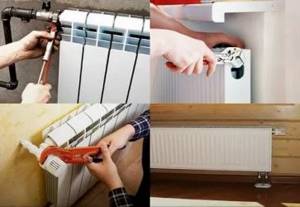
The degree of comfort depends on the room temperature. Therefore, the heating system must be given special attention, regardless of the size of the home. And it is necessary not only to install the heating system correctly, but also to use it adequately so that no repairs are required. Let's figure out how to properly turn on the heating battery in an apartment.
Starting the battery when heating is first applied
Several months pass between heating seasons, the water stagnates, and particles of rust appear. When the heating is first turned on, the pressure in the systems is increased, so all this dirt can get into the radiators with the flow of water. As a result of this, they will become clogged, due to which not all radiator legs will be heated - some of them will remain cold.
To prevent this from happening, at the stage of installing heating radiators it is necessary to install a bypass - this is a backup path that allows you to redirect the flow of liquid bypassing the heating device. Its installation is carried out parallel to the battery.
If a bypass is installed, its ball valve must be opened, but the battery ball valves must be closed.
Due to this, contaminated water will pass through the bypass, but will not enter the heating radiator. So you need to wait 2-3 days, and then close the bypass ball valve and open the battery ball valves.
Attention! It is important to know where to turn the valves on the radiator. To open them, you need to turn them counterclockwise, and to close them, you need to turn them clockwise.
Adjusting the temperature in the apartment
Some apartments are so hot in winter that the owners have to open the windows. In such cases, to create a comfortable microclimate, it is necessary to normalize the temperature regime.
To be able to adjust the temperature, one of the following methods is suitable:
- Use a thermostat. The principle of operation of the simplest thermostat is as follows: the user selects the regulator values from 0 to 5. When it is 5, all the water flows through the pipes, and 4, 3, 2, 1 - the diameter of the flow pipe will decrease, and a smaller amount of liquid will flow through the battery . The lower the value you select, the weaker the heating element will heat up.
- Use a thermostat - an electronic regulator. This is a device equipped with a temperature sensor and a processor. With its help, you can program the thermostat to operate in the desired mode. For example, during the day you can set the temperature to minimum values, and in the evening to optimal values. This option is suitable for everyday life, when all family members are away from home during the day. Such a device not only allows you to regulate the temperature, but also helps reduce heating costs by 20-30%.
- Shut off ball valves. If you close one tap, the battery will heat up more slowly. If you close both taps at once, the radiator will not heat up at all. In this way you can regulate the temperature if there are several radiators in the room. But during installation it is necessary to choose the right batteries - in one room it is better to use 2 batteries - for 8 and for 12 sections. Then it will be possible to turn off or turn on 8, 12 or 20 sections at the same time. When closing the taps, the battery should be cold. They cannot be shut off if the liquid in the system is hot. After all, when the temperature of the water decreases, its volume will decrease, a vacuum will form, and the pressure will increase, which can lead to damage to the radiator.
The use of regulators is the best option. This will allow you not to completely disconnect the battery, but only reduce its heating.
What to do with a stuck ball valve
If the ball valve is stuck, you can try to repair it yourself. For this:
- Unscrew the fixing nut and remove the handle. Below it is the upper part of the rod.
- If there is a hexagon clamping sleeve, you can loosen it a little.
- Using an adjustable wrench, turn the rod from side to side. Attention! You need to act slowly and smoothly. If you apply too much force or turn the key too quickly, you can deform the ball or the entire mechanism.
- Check the system. If the mechanism works normally and there are no leaks, you can install the adjusting knob. To do this, rotate it to the protrusions of the permitted degree of opening to determine whether it is possible to clamp the clamping sleeve all the way.
Important! If it is not known what material the device is made of, it is not recommended to repair it. After all, the use of additional mechanical tools can lead to its complete deformation.
To avoid damage to the ball valve, it is necessary to use only high-quality products. It is not recommended to purchase silumin devices with pipe wall thicknesses less than 2.8 mm. It is better to give preference to taps from European or Turkish manufacturers.
To prevent breakdowns, it is necessary to periodically change the position of the mechanism in order to develop the crane. It is recommended to do this at least once a month.
Conclusion
Thus, it is very important to know how to properly turn on the radiator. During this process, the above nuances must be observed. Otherwise, there is a risk that the heating device will become clogged, causing it to heat unevenly.
Source: https://zhkh.club/kvartira/kak-vkljuchit-batareju-otoplenija-v-kvartire
When to turn off radiators
There are several situations when you need to turn off the water in the battery:
- in the event of an emergency that threatens to flood your own and neighbors’ homes with hot coolant;
- if you decide to paint the radiator during the heating season;
- when you need to change or wash the battery without blocking the riser;
- you need to limit the flow of heat into a room that is hot in winter.

Radiators that are too hot are the cause of heat and stuffiness in the apartment
Note. Some apartment owners practice shutting off heating radiators for the summer while preserving the coolant. The goal is to protect heating devices from clogging during the autumn start-up of the system, when a lot of rust flows through the pipes. Below we will explain how to do this correctly.
Now the main point: you will never have problems with how to disconnect a radiator from a centralized system if it is connected according to the correct circuit using shut-off valves (ball valves). You will be able to shut off the coolant flow at any time if such a need arises, without disturbing the thermal conditions of adjacent apartments. The shutdown algorithm is simple:
- Close the lower and then the upper valve on the battery.
- If you plan to paint the heating device, then the previous step is sufficient. Wait until the radiator is cold and paint.
- When it is necessary to replace batteries in the middle of winter, before removing each heater, release the pressure through the Mayevsky valve. Then unscrew the bottom plug and carefully drain the water, then unscrew the joints and dismantle the device.
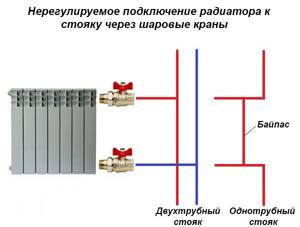
Correct connection of the heating device to the central heating risers
A separate question is how to properly turn on the heating radiator so that there is no air pocket left in it, which prevents maximum heating of the surface and air in the apartment. Here the algorithm is similar: you need to open the lower valve, then the upper one, and at the end release the remaining air using the Mayevsky tap.
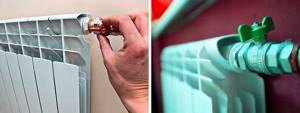
The handle stands along the axis of the pipe - the valve is open, across it - closed
Note. If you do the opposite and open the top valve first, you risk leaving some air inside the sections of the device. This is not critical, but the de-airing procedure will have to be repeated several times.
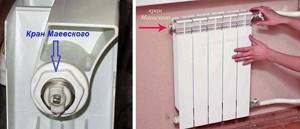
Location of the Mayevsky crane
In what order should the taps (valves) in the batteries be opened and closed?
There are two taps on the battery. They say that if you close them in the wrong order, you may experience water hammer.
For heat to enter, it is first necessary to bleed air from the radiator, so first we open the Mayevsky valve (bleeder) and make room for further steam (water) to enter.
As soon as the air is released, open the main valve (at the inlet) and wait for the batteries to start warming up. Water hammer is a real phenomenon, but it happens extremely rarely in apartments, so to avoid an accident you must follow simple instructions.
- When starting the heating radiator, you first need to bleed the air from the battery.
- Therefore, first we open the air valve, then the tap to open.
- Once water flows from the battery through the air valve, this will mean that the air has been released.
- We open both taps fully, the system will start working (water will circulate).
“>
If you need to shut off and remove the radiator
It is best to carry out work related to radiator removal after the end of the heating season. If work needs to be carried out during the heating season, you need to take into account a number of nuances. If you have a single-pipe heating system and vertical wiring, you can remove the battery only if there is a bypass.
Such a system can be identified by pipes, one of which comes from the ceiling and connects to the radiator, and the other comes out of the radiator and disappears into the floor. A bypass is a jumper connecting the incoming and outgoing pipes. This is a pipe of approximately the same or slightly smaller diameter than the main pipes. The principle of the bypass is as follows: if the radiator is turned off, water begins to flow through the riser, passing through the bypass, without passing through the battery. In this case, the riser works, the heating in neighboring apartments does not turn off.
If the system is two-pipe, if there are taps, it is enough to close them, after which you can remove the battery.
How to regulate heat in batteries
Suppose you put a battery of 10 bends in the room, and you feel good with it when it’s -20 degrees outside. But now, the cold has passed and now it’s been -2 degrees for several days. Hot water, as often happens with us, at the same temperature continues to flow through our pipes in a powerful stream and a gas chamber is formed in the room, from which there is no escape. In this case, the temperature regulator comes to the rescue. There are many of them in nature. In the picture below you see one of them.
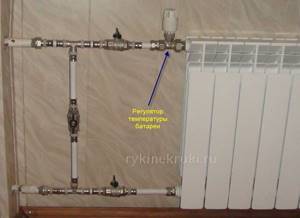
What brand of thermostat should be is the topic of a separate article. And now it is important for you and me to understand the principle. The figure shows one of the simplest thermostats. It has a knob on top that you can rotate and set values from 0 to 5:
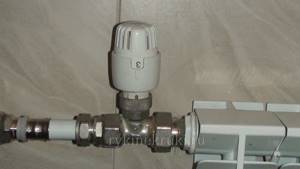
5 - means that the entire flow of hot water will pass through the battery; 4, 3, 2, 1 - means that the regulator will reduce the diameter of the flow pipe, providing less hot water flow through the battery per unit time. Thus, at 4 the battery will be colder, at 3 even colder, etc.
If you want to disconnect the battery altogether, you can set it to “*” - the water current will be very small. Practically it will not exist:
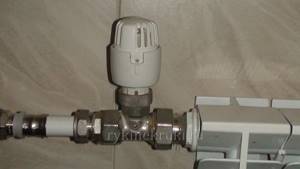
Or you can simply close the ball valves on the battery. The effect will be approximately the same:

If you have 2 windows in your room and 2 radiators under them, then during installation it is advisable to install them wisely. For example, you need 20 sections for the entire room. Then it is better to put, for example, 12 sections on one battery, and 8 sections on the other. In this case, in addition to the regulator on each battery, you can completely turn off or turn on 8, 12 or all 20 sections at the same time.
How to disconnect the battery in an apartment yourself
If you plan to replace the heating risers, or simply decide to change the batteries, you need to turn off the heating. When the heating system is equipped with ball valves or other shut-off valves, it is quite simple to solve the problem of how to shut off the heating battery in an apartment and shut off the flow of liquid to the radiator. To do this, during the period between heating seasons, it is necessary to turn the shut-off valve to the desired position so that water does not flow into the heating device.
At the height of the heating season, it will be more difficult to remove the battery. A bypass helps solve the problem and not disrupt the functioning of a single-pipe heating system. This is a kind of jumper installed in front of the heating device and connected parallel to the battery. The bypass diameter should be equal to or slightly smaller than the diameter of the main circuit pipes. Of course, it is better to do all this when the heating season ends and the heating supply is turned off.
A tap is installed on the bypass, with which you can change the direction of fluid flow in the heating circuit. In the normal bypass state, the coolant flows through the heating device. If there is a need to shut off the water supply to the coolant, the bypass valve should be opened. In this case, the water moves through the main pipeline without capturing the radiator.
Horizontal heating - how to combine efficiency and comfort

Today, every potential apartment buyer should know what lies behind the words horizontal heating. The developer usually talks about such a heating layout as an undeniable advantage. However, you need to understand that there are several options for horizontal distribution of heating pipes, and each of them has its own advantages and disadvantages. But first things first.
A heating pipe emerging from the ceiling of an apartment, wrapping itself in a radiator and disappearing into the floor has become taken for granted over the years. If the apartment is hot, open the windows; if it’s cold, dress warmly. But now new buildings have appeared in which the heating pipes are laid out within the apartment, sometimes even according to an individual project as part of the apartment planning work. What prompted developers to take such a step, and what does this give to buyers?
An increasing part of modern houses are being built using monolithic technology. Cutting holes in their strong power structure for vertical heating distribution is a rather labor-intensive solution. It is much easier to do horizontal wiring. True, in this case, what is easier for the builder turned out to be good for the buyer.
Advantages of horizontal wiring
Horizontal wiring implies the presence in the apartment of inputs that allow connection to a single powerful heating riser. It is from this that pipes are laid to all heating radiators. This allows:
- install heat meters for each apartment;
- regulate heat energy consumption based on your preferences;
- disconnect the apartment from the general heating system at any time, for example, to carry out urgent repairs;
- ensure the independence of the heating system of each individual apartment from its neighbors.
In other words, you can consume as much heat as you need to maintain a comfortable temperature in your apartment, and not overpay for heat that you don’t need.
One-pipe and two-pipe wiring
But sometimes it is necessary to set different temperatures within the same apartment. For example, slightly cool a kitchen heated by a hot oven or provide the pediatrician-recommended temperature of 18 degrees Celsius in the bedroom of a child suffering from a runny nose. Whether it will be possible to regulate the temperature individually within a room depends on the wiring option.
Two-pipe wiring is when two separate pipes go to each battery from a heating device or central input, that is, each battery is connected in parallel. In this case, the flow of coolant to each of the batteries can be regulated separately, including using automation.
Proper disconnection of radiators
The owner of a private house with an autonomous heating system has the opportunity to turn off the boiler at any time, depending on the weather outside or based on other considerations.

To shut off the heating device, ball valves are required
For those who live in houses with central heating, questions about how to turn off the radiator usually arise in two cases:
- if the weather is warm outside and the central heating has not yet been turned off, since the heating season has not officially ended;
- if necessary, replace, repair or paint the radiator, repair the wall behind the radiator.
In this case, one should take into account this point: there is always a coolant inside the battery. It is drained only in case of repair work in the system
This is due to the fact that the main part of the heating devices installed in old houses, as well as the intra-house wiring, are made of steel.
The liquid inside the heating battery contains a certain amount of oxygen in dissolved form, which over time completely reacts with the metal, as a result of which corrosion stops.
You cannot leave the system or a separate heating device unfilled for a long time - moisture remains on the inner surface of the steel or cast iron battery, which does not evaporate for a long time in a confined space. This significantly accelerates the corrosion process. Thus, the coolant is drained only in exceptional cases.
How to turn on radiators correctly?
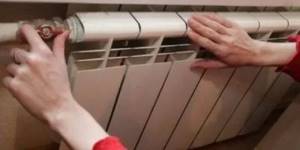
Happy owners of new apartments, residents of housing who have made major repairs and decided to abandon the services of centralized heating, are awaiting the arrival of cold weather with some caution and apprehension. Many people ask one question. How to turn on the heating in your apartment if you do all the necessary work to install autonomous heating yourself? Are the radiators connected correctly, will the new, independent heating system in the apartment work normally in the future?
Your comfort and living conditions in the apartment depend on how correctly the new heating system is installed in the apartment and how the heating equipment is installed.
The main problem that will have to be solved by switching to your own heating system in the apartment
All repair and technical work with elements of the heating system in apartments must be carried out before the onset of cold weather, when the heating season has not officially begun. It is during this period that it is time to reconstruct the heating in the house.
How to shut off a heating riser
The heating riser belongs to common property. It must be blocked by employees of the service organization who have the right to do so.
If you follow the letter of the law, you must come to the DEZ, Housing Office, DEU, etc., write an application, pay for the service at the cash desk. At a certain time (indicate in the application) a representative of the service organization must come and turn off the valve in the basement.
How much does it cost to turn off the heating riser? This is not an easy question. The fact is that there are no fixed prices. There is a price list for services, but it is only a recommendation. In reality, each organization sets its own prices. On average, you will have to pay from $15 to $20 for this operation.
There is a workaround. Agree with neighbors and shut off the riser yourself without the campaign’s knowledge. But you know that this is not always possible: neighbors are different. If in the summer, when the heating is turned off, such actions may meet with understanding, then during the season - it is unlikely. There is another difficulty: the heating valve is not always easy to find. You either need to have a communication scheme, or just know where it is. They usually know a locksmith. But they won’t block the riser for free, and will require at least $10-15. There seem to be savings, but they are small. And if this fact becomes known to the management or operational company, you will face substantial fines.
Why is the water not drained at the end of the heating season?
As you know, water remains in heating networks even in summer. This is explained by the fact that in this way corrosion processes inside radiators and pipelines are reduced. And it is water that will help prevent corrosion, since in this case steel and cast iron will be much less susceptible to rust. No matter how paradoxical it may sound, it really is so. For what reasons does this happen? Everything is quite simple: (See also: How to disassemble a cast iron heating radiator with your own hands)
- Water is constantly inside the heating system and does not allow metal to come into contact with air. Corrosion occurs when a metal comes into contact with dissolved oxygen in water;
- Due to the isolation of the heating system from the outside world, the water is quickly deprived of dissolved oxygen. Then the oxidation process, which is usually a catalyst for corrosion processes, is completely eliminated.
- As a result of all this, the heating network does not rust at all from the inside, which cannot be said about the cold and hot water pipeline system. However, if water is removed from the system, moist air with a high oxygen content will remain. This is precisely why pipes and radiators rust from the inside in the absence of coolant. (See also: How to calculate bimetallic heating radiators)
Before turning off the radiator, you need to study the other side. According to established standards, the heating network must always contain water. At the same time, some management organizations often neglect this requirement in order to save money. Thus, during repairs, it is necessary to drain water from the system, and then refill the network with it, wasting time. If batteries are replaced and repaired in several apartments over the course of one summer, the management company will have to drain and refill the system each time. Therefore, in some cases, pipes are left without water at all during the summer. Due to the closed system, the pipes will not be able to dry from the inside, and moisture will trigger corrosion processes.
Why do you need to make adjustments?
The main factors explaining the need to change the heating level of batteries using locking mechanisms and electronics:
- Free movement of hot water through pipes and inside radiators. Air pockets may form in the heating system. For this reason, the coolant stops heating the batteries, as it gradually cools. As a result, the indoor microclimate becomes less comfortable, and over time the room cools down. To maintain heat in the pipes, shut-off mechanisms installed on radiators are used.
- Adjusting the temperature of the batteries makes it possible to reduce the cost of heating your home. If the rooms are too hot, by changing the position of the valves on the radiators you can reduce costs by 25%. Moreover, reducing the heating temperature of the batteries by 1°C provides savings of 6%.
- In cases where radiators heat up the air in the apartment very much, you have to open the windows often. It is not advisable to do this in winter, because you can catch a cold. To avoid having to constantly open windows in order to normalize the microclimate in the room, regulators should be installed on the batteries.
- It becomes possible to change the heating temperature of radiators at your discretion, and individual parameters are set in each room.
If you need to shut off the radiator without removing it
If you need to shut off the heating radiator for the summer or turn it off because of the heat, this is easy to do if there are shut-off valves on the heating radiator - ball valves. Fully turn the handle of the valves on the inlet and outlet pipes. This will block the flow of coolant.
In the photo the taps are open. When closed, the valves of the taps are located perpendicular to the pipe.
Often there is a special adjustment valve on the incoming pipe. It can also be used to block a pipe. However, its main function is to maintain a certain temperature in the room.
Shutting off the radiator without dismantling it is carried out in the following cases:
- The battery needs to be painted (during the heating season).
- The battery needs to be flushed.
- Gaskets and nipples need to be replaced.
- It is necessary to turn off the heating battery for the summer.
Recommendations for installing devices
To be able to regulate the temperature of the battery in the apartment, consider any type of valve: they can be straight or angular. The installation principle of such a device is simple; the main thing is to correctly determine its position. Thus, the direction of coolant flow is indicated on the valve body. It must correspond to the direction of water movement inside the battery. Place valves/thermostats at the inlet of the heating device; if necessary, install a tap at the outlet as well. This is done so that in the future it will be possible to independently drain the coolant. Regulating devices are installed on heating radiators, provided that the user knows exactly which pipe is the supply pipe, since a tap is made into it. In this case, the direction of movement of hot water in the riser is taken into account: from top to bottom or from bottom to top. Compression fittings are more reliable, which is why they are used more often. The connection to the pipes is threaded. Thermostats can be equipped with a union nut. To seal the threaded connection, use FUM tape or flax.
Who to entrust the work to?
Since you will still have to pay, it is better to do everything at once. In any case, with all the radiators on one riser. And here the question arises: who will carry out this work. To get started, you can go to the housing office or departmental office and ask about their prices. As a rule, the prices there are rather high, and the quality of work is not up to par. To make sure of this, you can ask neighbors who have already dealt with them.
You can find a private owner. Just not from advertisements, but from the recommendations of acquaintances, colleagues, friends. Their prices are rarely higher than those of operators. And the quality is better - this is their bread: if they do a bad job, there will be no customers. That’s why they try (if they are sane) to do everything conscientiously.

Choosing a performer is not an easy task
There is still an opportunity to negotiate with the housing office employee by bypassing the cash register. But here the option is controversial. Firstly, they tend to ask for a price based on the client’s wealth and it is far from a fact that they will demand less than the price list. More likely - more. Why, tell me, should they pay more for the same quality of work (it is unlikely that they will work more diligently than at their main job)?
Another option is to contact a specialized organization. And again, preferably based on recommendations. Although, organizations are forced to monitor the quality of work for prosaic reasons: they need clients. If they have a bad reputation, no one will go to them
Therefore, if you don’t know the organization, there are no recommendations, you can pay attention to the period of its existence on the market. If it’s not a year or two, then they definitely know how to do something, otherwise they wouldn’t have existed for so long
Naturally, pay attention to the services they provide. Many people suggest that issues with permission and disconnection of risers should be handled by the management or operating organization. You just specify the list of works and time. How expensive will it cost? In different ways: organizations, like their leaders, are different. It may be more expensive than the work of a mechanic from the housing office, but at least you will have someone to file a claim with in case of problems: you sign an agreement that will clearly outline who is doing what.
And the most economical option: do everything yourself, with your own hands. It’s not an easy task, but it’s not the gods who burn the pots. Just first you need to find out everything down to the smallest detail, purchase everything you need, prepare tools and equipment, and only after that write an application to turn off the riser.
How to do it right?
And the correct thing to do would be to open one tap and close the second. I personally always open the top tap and close the bottom tap. Thus, the presence of water in the battery throughout the entire period: spring - summer - autumn - winter will be ensured, and a vacuum will not form in this case. The battery will be fine.
Attention!
But now, autumn has come. And we read an announcement that the heating should be turned on the next day. What are our actions? We remember that the moment water is supplied, rust will flow through the pipes. To avoid clogging the battery, turn off both taps! Don’t worry, even if the next day it so happens that frost is predicted, the water in the battery will not have time to cool down enough during the day that a vacuum will form in it. After all, your battery is still located in the apartment, and not on the street.
Yes, by the way, the jumper should always be open during these periods!
So, hot water was served. She ran through the bypass. And great. It’s better not to turn on the battery at all for 1-2 days. Let all the rust pass you by!
From the bypass, the water in the battery will begin to heat up a little. Heating the water will increase the pressure inside the battery. But don't be alarmed. Just heating is not scary! Again we remember our bottle from childhood. Has anyone tried to trick her? Obviously, this was much more difficult to do than suck the air out of her. The same effect applies to the battery. A slight increase in pressure due to an increase in temperature cannot in any way lead to deformation of the battery.
After 1-2 days of hot water flowing through the jumper, we open both taps on the battery and welcome the new heating season. Well, dear readers, that's all! I hope this short essay has shed light on the fact that heating in an apartment must be controlled!
Very important information
Below we will describe situations when one or another inclusion of the battery may be undesirable, and sometimes unacceptable!

4.1.You cannot use the thermostat without a jumper
In point 2 we talked about the thermostat. However, you need to understand that experiments with a temperature controller are only possible with a jumper! If it is not there, and you reduce the diameter of the flow pipe, then the total flow of hot water through your apartment will decrease. Which of course is unacceptable, otherwise your neighbors will come to you!
4.2. The thermostat may become clogged
If you are using a jumper, but for some reason it was turned off for a while and the thermostat was set to position 5, i.e. provided a full flow of hot water only through the battery, as shown in the figure:
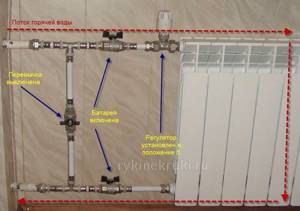
then everything seems to be fine. However, we must accept reality as it is. Even if we turned on the central heating radiators correctly for the first time, there is no guarantee that, for example, in a month or two a new mud flow will not pass through the pipes. But then, if the jumper is turned off, then the splash of dirt will go straight to your thermostat, which, in fact, is very sensitive to it. As a result, a blockage forms in the thermostat, and water will not flow into the battery at all. It won’t go into the jumper either, because you closed it. Therefore, in this situation, water will stop flowing through your apartment; in the house, through your heating riser, the water will also stop and begin to cool in the cold. As a result, a squad of evil neighbors, together with the chairman of the HOA or housing cooperative, is guaranteed to enter your apartment.
It is clear that switching on according to the above figure is similarly not acceptable for the regulator positions 4,3,2,1,*
4.3. The jumper must always be on
Make it a rule that it doesn’t matter whether you use a temperature controller or not, but the jumper should always be on. This way, you will always ensure hot water flow through your apartment. When does it make sense to turn off the jumper? For example, when you feel that the battery is clogged. Then you let all the water flow through the battery by disconnecting the jumper. Perhaps a more powerful stream of hot water will be able to push through the stuck dirt. But this needs to be done for a short time and only under your control - you cannot leave the situation like this and go to sleep. The fact is that if the dirt cannot be pushed through, then a congestion will form again: water will not be able to pass through either the battery or the jumper.
4.4. During installation, the thermostat must be installed behind the jumper, i.e. directly in front of the battery
This is mega important, because if it is installed before the jumper, then when you first turn it on, dirt will definitely clog your thermostat, and you will start the heating season with a complete rewiring of the battery:
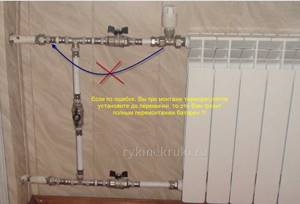
4.5. Avoid outright carelessness when installing ball valves in different positions
This installation of ball valves in your system will again ensure that your neighbors come to you:
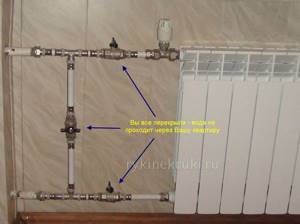
You just completely turned off the water :).
Well, that's all, dear readers! I tried to tell you in as much detail as possible about the nuances of operating heating batteries!
Have you ever accidentally blocked the heating pipe in your house?
Why is the water not drained at the end of the heating season?
As you know, water remains in heating networks even in summer. This is explained by the fact that in this way corrosion processes inside radiators and pipelines are reduced. And it is water that will help prevent corrosion, since in this case steel and cast iron will be much less susceptible to rust. No matter how paradoxical it may sound, it really is so. For what reasons does this happen? Everything is quite simple: (See also: How to disassemble a cast iron heating radiator with your own hands)
- Water is constantly inside the heating system and does not allow metal to come into contact with air. Corrosion occurs when a metal comes into contact with dissolved oxygen in water;
- Due to the isolation of the heating system from the outside world, the water is quickly deprived of dissolved oxygen. Then the oxidation process, which is usually a catalyst for corrosion processes, is completely eliminated.
- As a result of all this, the heating network does not rust at all from the inside, which cannot be said about the cold and hot water pipeline system. However, if water is removed from the system, moist air with a high oxygen content will remain. This is precisely why pipes and radiators rust from the inside in the absence of coolant. (See also: How to calculate bimetallic heating radiators)

Before turning off the radiator, you need to study the other side. According to established standards, the heating network must always contain water. At the same time, some management organizations often neglect this requirement in order to save money. Thus, during repairs, it is necessary to drain water from the system, and then refill the network with it, wasting time. If batteries are replaced and repaired in several apartments over the course of one summer, the management company will have to drain and refill the system each time. Therefore, in some cases, pipes are left without water at all during the summer. Due to the closed system, the pipes will not be able to dry from the inside, and moisture will trigger corrosion processes.
